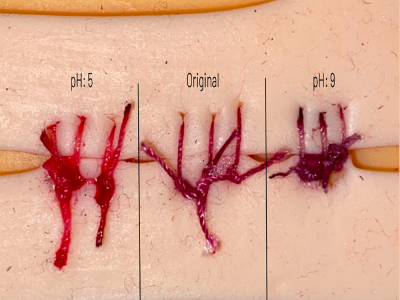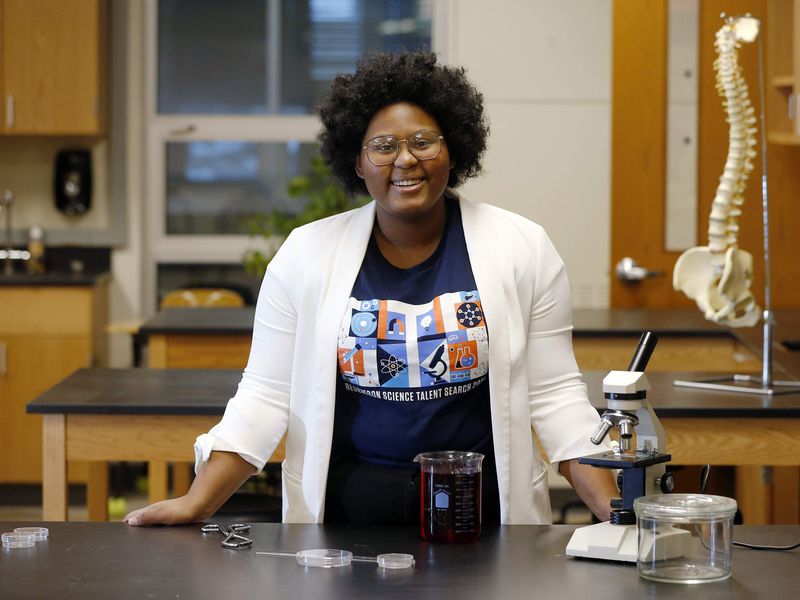If you’ve ever had surgery, you know firsthand how important it is to keep the wound from getting infected. There are special conductive sutures that sense changes in wound status via electrical signal and relay the information to a computer or smart phone. As awesome as those sound, they’re a first-world solution that is far too pricey for places that need it most — developing countries. And surgical wounds in developing countries are about four times more likely to get infected than those in the US.
 Iowa high-school student [Dasia Taylor] found a much simpler solution that could drive down the infection rate. She used beets to develop color-changing sutures that turn from bright red to purple within five minutes if an infection is present.
Iowa high-school student [Dasia Taylor] found a much simpler solution that could drive down the infection rate. She used beets to develop color-changing sutures that turn from bright red to purple within five minutes if an infection is present.
Beets, and other fruits and vegetables like blackberries, plums, and blueberries are natural indicators of pH. They have a compound called anthocyanin that gives them both their pigment and this cool property. Beets are perfect because they change color at a pH of nine — the same pH level of infected human skin, which is normally around five.
[Dasia] experimented with several types of suture thread to see which ones would absorb the beet juice in the first place. She settled on a cotton-polyester blend that is braided. While it probably helps absorb the beet juice, it would also give bacteria several places to hide. Another problem is that many surgeries involve cutting muscle, too, and by the time a deeper infection would show up on the sutures, it would be pretty late in the game. But if these color-changing sutures can be made to be cost-effective, safe for skin, and of course, keep wounds together, this solution is way better than nothing at all and definitely worth producing. You can see [Dasia] talk about her project in the video below.
Want to know more about natural pH indicators? Sure you do.

















Practicality aside, the concept of using pH to activate a chemical alarm is sound. With a bit of bioengineering, you could modify an organism to produce the material for the sutures that incorporates a pH trigger like beets. However, it would be better if trigger caused all connected material to change.
This goes in the category of “why didn’t anyone think of that before!” This is a great idea. Ms. Taylor has a very bright future ahead of her.
I don’t know if you work in the medical field but have you seen sutures that were put in a patient for a while? They are often stained with blood or other chemicals such as iodophorm so their color will be different than when they are new in a package. Plus, it’s relatively straightforward to tell if a surgical wound is infected just by looking at it. Also, people have developed bandages that use the same mechanism in order to detect infection. Any reason why they haven’t taken over the market?
That being said, much kudos to her for coming up and implementing the idea. It’s just not very practical/helpful overall given many other variables.
“Plus, it’s relatively straightforward to tell if a surgical wound is infected just by looking at it”
Have you seen how fricking oblivious people in real life can be? Sure, medical professionals could tell an infected wound, but there are a lot of people who practically need something to scream in their faces about it.
Why would you want non-medical people making decisions on whether a wound is infected or not? You have scheduled follow ups, home health skilled nursing services, and if needed urgent care/emergency services available to do so. I’ve seen patients with post operative wounds that have swelling, warmth, and redness to the entire area, pus dripping out, and the most pungent odor you could ever dream of come in and don’t think they have an infection. You think just a suture changing color will get them to change their mind? You got to be kidding. Oblivious people will be oblivious no matter what. For people that have common sense, just follow the post-op instructions and call the provider’s office if there are any questions.
“Why would you want non-medical people making decisions on whether a wound is infected or not?”
So they would go and have the wound checked immediately, once they notice the infection,, instead of just waiting until the scheduled time of appointment! Geesh.
“So they would go and have the wound checked immediately, once they notice the infection,, instead of just waiting until the scheduled time of appointment! Geesh.”
Read my reply again. I said urgent care and emergency department are out options. I didn’t say that had to wait for an appointment. They have plenty of other signs and symptoms to look for that are readily available and free to utilize (pain, redness, swelling, discharge, odor) to suggest infection rather than looking for color change on a suture.
*1 this
” In cases of local infection, the pH rose prior to the onset of clinical signs of local burn infection.”
https://pubmed.ncbi.nlm.nih.gov/25468471/
In sutures to detect infections it is.
yes, so novel https://patents.google.com/patent/US20090142275A1/en?q=Infection+detection+sutures&oq=Infection+detection+sutures
The only way to scientifically determine the effectiveness of this idea requires animal cruelty. i.e. You’d have to actually prove that you can detect all typical infections in an actual wound in a living organism. The alternative is to do what nobel prize winners are prepared to do, and experiment on yourself, which is not advisable unless you are an expert. Assuming that a provable ph change in dead tissue implies that actual infections can be detected in living tissue is half baked science. It will be interesting to see if she can finish the job and actually confirm her hypothesis. I have my doubts r.e. deep infection and its influence on the visible parts of the sutures, assuming that the anthocyanin would even survive normal disinfection and cleaning measures, so that needs testing too. Actually that should be tested before any animal cruelty is considered necessary.
You don’t need animal cruelty. You can simply test existing patients for pH changes.
People ARE animals!
I’m a practicing surgeon and don’t too often see primary closures of the skin with sutures for lots of reasons, among them, skin reactions. More commonly for either traumatic or surgical wounds, staples (typical or subcuticular) , subcuticular sutures and/or Dermabond (cyanoacrylate, ie super glue) would be used. Providers assess infections as already noted, by examining the wound and observing for pain, induration, erythema, purulent discharge, frankly necrotic tissue. Upon suspecting an infection, antibiotics and wound cleaning instructions may be given at that point. Just as many/most providers aren’t too fond of patients researching medical answers via Google, I wouldn’t want/expect patients to review their sutures for color changes. I’d prefer patients keep their routine 2-week and 6-week follow-up appointments or simply come in for a nurse visit off-schedule if needed.
That being said, kudos for the effort and perhaps people like her will develop new skin closure techniques.
“I’m a practicing surgeon” Practicing? Call me when you get it right! (Sorry, but I’ve always wanted to make that joke but never met a surgeon I could make it too.) But I’m sure that you are aware that many patients will not keep their follow-up, maybe a visible sign on their wound would make them more likely to come in if they have an infection? Also even if different wound closure techniques are used a surgeon, nurse, qualified seamstress could put in a couple of “warning sutures” just to monitor the wound?
Out at the primary care coalface interrupted sutures are used all the time for biopsy site and wound closure.
In resource poor environments in developing countries and/or possibly parts of some western industrialised countries (i.e. no practically accessible universal health care entitlements), the idea of simplifying wound review and followup like this sounds eminently worthy of further exploration.
Not sure how it would work with prolene or nylon, but it might work just fine on gamma irradiated silk.
WOW! A comment on the internet taking away from someones achievement – you’re pioneering the world, my friend.
Thread soaked with indicator – disruptive technology achievement unlocked!
This is a really cool idea, but the red in beets is from betacyanin, not anthocyanin.
Funny. I though that I live in the first world but I’ve never been told after surgery that I could sync my sutures to my phone and monitor my healing status.
Seriously, does everything need to be a first/third world thing? Why not just help everyone for the purpose of helping everyone? Who wouldn’t want color changing sutures that alert them to an infection?